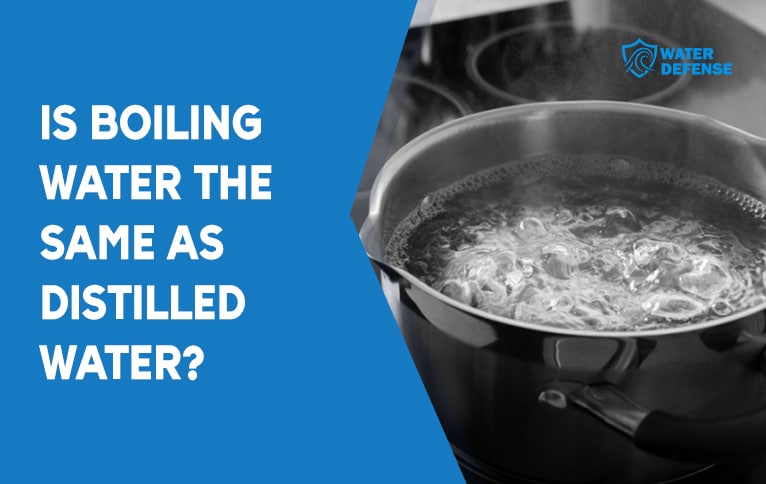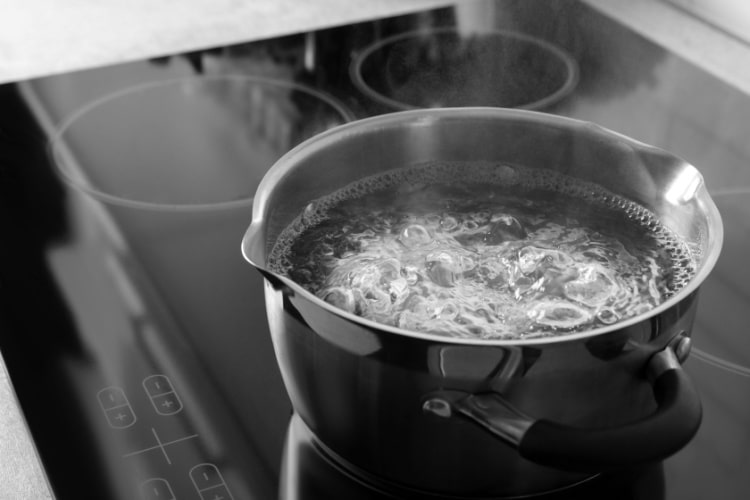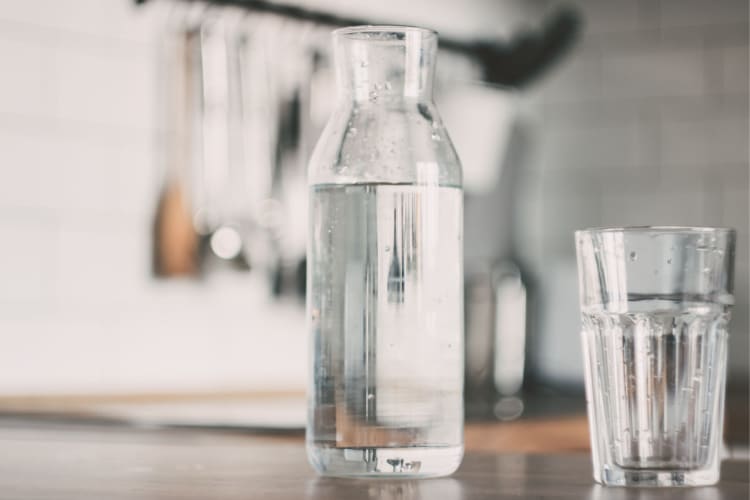Two of the most conventional water treatment methods, boiling water, and distilling water, require you to heat the water. That’s why some people confuse the two with each other or are inclined to think they’re the same.
However, boiled water isn’t the same as distilled water at all.
Although the water is heated in both, that’s the only thing these two water treatment methods have in common. Subsequently, the outcomes of these methods aren’t the same in terms of removed contaminants and water quality.

So let’s explain what these two methods are. Then, we’re going to list the differences between the two.
How Do Boiled Water and Distilled Water Differ?
Boiling water means heating it until it reaches its boiling point; more often than not, this process takes place in one container. Distilled water, on the other hand, is boiled until it’s all vapor, and then the vapor is transferred to another container, to be condensed and returned to its liquid state.
Impurities can’t hold on to the hydrogen or oxygen molecules in the water’s vapor state. That’s not the case for boiling water, which makes distilled water purer than boiled water.
Now, let’s shed more light on the differences between these two water treatment techniques.
Boiling/Boiled Water

To boil water, you only need a heat source, like a stove, and a water container that can withstand heat, like a pot, pan, or kettle.
Once you heat the water up to 212 degrees Fahrenheit or 100 degrees Celsius at sea level, it starts bubbling, meaning it’s boiling. As the altitude increases, the boiling point of water decreases. To calculate how much heat you need to boil water at your altitude, you can consult online boiling water calculators.
Altitude also affects how long you need to keep boiling the water. If you are below 6,500 feet altitude, boiling it just for one minute will be enough. If you’re above 6,500 feet, we recommend boiling it longer than two minutes.
Boiled water is free of microorganisms such as bacteria, viruses, protozoa, and microbes because heat destroys these pathogens. However, no matter how long you boil the water, boiling is not an effective method of eliminating minerals, salts, and hazardous impurities such as chemicals and heavy metals.
As such, boiled water isn’t ideal for use in fish tanks because the fish have a very specific mineral intake range. Additionally, even though it has no pathogenic microorganisms, it’s not really a great idea to drink the water you have boiled from a roadspring, river, or lake, simply because you don’t know its overall makeup.
However, if pathogenic microorganisms have infiltrated your municipal water supply and the water is otherwise safe for consumption, the municipal authorities might issue a boil water notice, in which case this treatment method is appropriate on its own.
Distilled Water

Distilled water, in the simplest terms, is water that’s subjected to vapor distillation. Although it’s a conventional method, nowadays it’s mostly utilized in industrial-scale water treatment operations.
The technique requires a large water tank, transfer pipes, and a second tank.
Similar to boiling, the water is heated up to 212 °F in distillation, and then that temperature is maintained until the water is vaporized. The vapor is then transferred through the pipes to the second tank where it’s condensed and cooled so that it can turn back to its liquid state.
As the distance between the hydrogen and oxygen atoms increases in gas form, the impurities can’t find any molecules to hold on to. So, almost all atoms that don’t belong to hydrogen and oxygen are eliminated during this process, including minerals, salts, heavy metals, and chemicals.
Since the heat is the same as boiling, distillation destroys microorganisms as well.
In summary, there’s only hydrogen and oxygen atoms in distilled water. In that sense, it’s one of the safest drinking water options. But the lack of essential minerals (calcium, magnesium, potassium, etc.) means distilled water is inferior to spring water as drinking water.
Distilled water isn’t typically used for drinking — it has other areas of use:
- It’s ideal for household chores like car washing, laundry, dishwashing, and cleaning surfaces. Normally, water that has too much mineral and salt content leaves hard water stains on cars, clothes, kitchenware, and surfaces. There’s no such risk with distilled water.
- Its purity makes it the best choice for scientific experiments.
- It’s the perfect option for kidney dialysis and sleep aid (CPAP) machines as well as houseware such as dehumidifiers, humidifiers, and irons since it has no contaminants or minerals.
- It’s the primary ingredient for baby formulas and infant cereals. Some parents want to have complete control over their baby’s mineral intake, so they prefer mineral-free distilled water.
Conclusion
Boiled water is water that’s heated up to 212 °F and boiled for a minute or so. The whole process requires one single water container. Distillation, on the other hand, means all the water is turned into vapor and requires two containers and transfer pipes.
Due to this difference between the methods, the end product differs in terms of contaminant presence. While boiling is only effective against microorganisms, distillation removes all impurities.
As such, while boiling water is only useful when the municipal authorities issue a boil notice due to pathogenic contamination, distillation has a wide variety of uses. It’s ideal for household chores, scientific experiments, kidney dialysis and CPAP machines, houseware, and baby formulas and infant cereals.